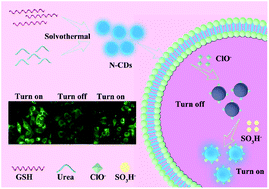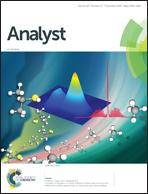“ON–OFF–ON” fluorescent probes based on nitrogen-doped carbon dots for hypochlorite and bisulfite detection in living cells†
Abstract
Although hypochlorite (ClO−) and bisulfite (HSO3−) play important roles in the biological immune system and the aging process of living organisms, they are also classified as a third type of carcinogens. Hence, a convenient and efficient method to monitor ClO− and HSO3− in ecological environments is highly desired. In this article, an “ON–OFF–ON” fluorescent probe based on nitrogen-doped carbon dots (N-CDs) for the detection of ClO− and HSO3− has been demonstrated successfully. Because of the destruction of the surface passivation layer, the fluorescence of the N-CDs was quenched by ClO−. Furthermore, the quenched fluorescence of the N-CDs was restored efficiently through the increase in conjugation from the attached sulfo groups, indicating the feasibility of ClO− and HSO3− detection. This fluorescent probe exhibited excellent sensitivity and selectivity to ClO− and HSO3− detection with the limits of detection (LODs) of 3.4 μM and 0.27 μM in aqueous solution, respectively. In addition, the as-prepared N-CDs were successfully applied to detect both ClO− and HSO3− in living cells due to their low toxicity and fast response speed.



 Please wait while we load your content...
Please wait while we load your content...